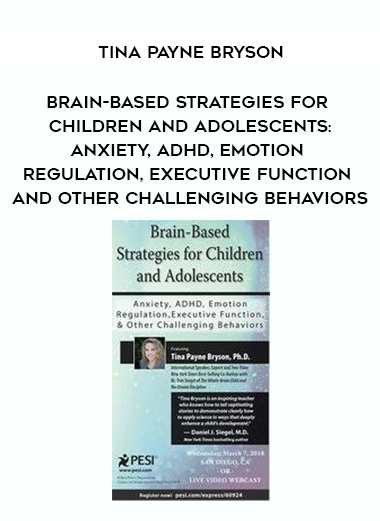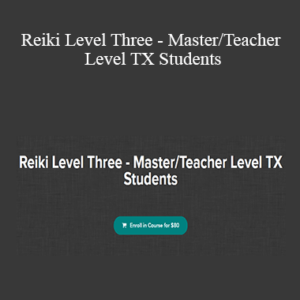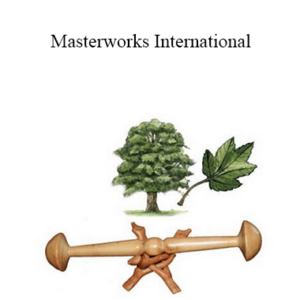[Download Now] Brain-Based Strategies for Children and Adolescents: Anxiety, ADHD, Emotion Regulation, Executive Function and Other Challenging Behaviors – Tina Payne Bryson
Sale Page_https://catalog.pesi.com/item/30595/
Archive: https://archive.fo/FGtsT
Watch Dr. Tina Payne Bryson, international speaker and co-author with Daniel J. Siegel, M.D. of The New York Times bestsellers The Whole-Brain Child and No-Drama Discipline, as she revolutionizes the way you treat behavioral, emotional and somatic challenges using brain-based strategies for children and adolescents.
This workshop will use an interpersonal neurobiology lens to focus on bilateral and vertical brain integration that will challenge your current ways of understanding and treating behavioral and emotional struggles. Using stories, case studies, videos and humor, Tina will provide creative strategies on how to integrate brain science into your practice and personal life. Dive into the neurobiological aspects of attachment and narrative. Learn the latest on neuroplasticity, plus experience the changing brain in a way that’s clear, interesting and practical.
- Acquire new tools to help children and families with:
- Anxiety
- ADHD
- Attachment
- Behavioral avoidance
You will walk away with a new framework for treating children, adolescents and families along with effective strategies to improve attention, emotional regulation and resilient flexibility!
- Evaluate clinical intake and assessment processes to more effectively treat symptoms of anxiety, ADHD, emotion regulation, executive function and other challenging behaviors in children and adolescent clients.
- Utilize whole-brain strategies to build a client’s resilience for difficult transitions and regulate emotional reactivity.
- Demonstrate multiple approaches to help anxious children comprehend fundamental facts about the brain, for purposes of client psychoeducation, to help understand their own brains, and how nervous systems contribute to their overall perspective of their world and themselves.
- Integrate an interpersonal neurobiology framework to enhance mental health treatment with children and adolescent clients.
- Implement brain-based, age-appropriate clinical strategies to promote resiliency in children.
- Explore the neurobiological basis of attachment theory and utilize this information to inform clinician’s choice of treatment interventions.
- The Whole-Brain Child – Integration Strategies
- Science of integration and well-being
- Bilateral integration: left/right brain
- Name it to tame it
- Connect & redirect
- Surfing emotional waves
- Build resilience for difficult transitions
- Vertical integration: upstairs/downstairs brain
- Strategies to regulate emotional reactivity
- Reduce fight, flight, freeze responses
- Teach clients about their brains
- Use it or lose it and neuroplasticity
- Emotions and Behaviors – Regulation Strategies
- Rethink intake and assessment
- Nervous system arousal/investigate toxic stress and co-regulation
- Zones of arousal physiological, emotional, and behavioral correlates
- Role of curiosity/beyond diagnoses and limits of our lens
- Interdisciplinary, interpersonal neurobiology approaches to mental health
- Role of sensory processing and information processing
- “Bottom-up” approaches
- Impact of movement on the nervous system
- Dysfunctional emotional regulation/ formulate a treatment approach
- Challenge typical diagnoses with arousal and relationship in mind
- Case studies
- A Neurobiological Lens of Attachment
- How attachment wiring impacts the attentional system and narratives
- Mental models and neurological wiring
- Weave attachment into treatment and change models
- Narrative and the attempt to understand the present functioning
- Attachment experiences in the classroom
- Using relationship to regulate neurophysiological states
- Specific Brain-Based Strategies
- Anxiety disorders
- ADHD
- Attachment
- Behavioral avoidance
- Emotional dysregulation
- Executive function
- Oppositional/disruptive behaviors
- Shifting attachment patterns
- Stress modulation
- Trauma
Tag: Brain-Based Strategies for Children and Adolescents: Anxiety, ADHD, Emotion Regulation, Executive Function and Other Challenging Behaviors – Tina Payne BrysonReview. Brain-Based Strategies for Children and Adolescents: Anxiety, ADHD, Emotion Regulation, Executive Function and Other Challenging Behaviors – Tina Payne Bryson download. Brain-Based Strategies for Children and Adolescents: Anxiety, ADHD, Emotion Regulation, Executive Function and Other Challenging Behaviors – Tina Payne Bryson discount.
Delivery Method
– After your purchase, you’ll see a View your orders link which goes to the Downloads page. Here, you can download all the files associated with your order.
– Downloads are available once your payment is confirmed, we’ll also send you a download notification email separate from any transaction notification emails you receive from coursesblock.com
– Since it is a digital copy, our suggestion is to download and save it to your hard drive. In case the link is broken for any reason, please contact us and we will resend the new download link.
– If you cannot find the download link, please don’t worry about that. We will update and notify you as soon as possible at 8:00 AM – 8:00 PM (UTC 8).
Thank You For Shopping With Us!







